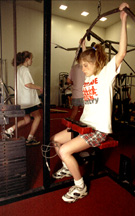 Purdue News
Purdue News
 Purdue News
Purdue News
 "High-school girls who are at least moderately active can increase the density of
certain bones at a rate unrivaled at any other time in their life," says Dorothy
Teegarden, assistant professor of foods and nutrition at Purdue University. "Particularly
the hip bone. That can be important, because hip bone fractures are one of the most
common fractures among the elderly. An older person can suffer serious injury -- even
death -- from breaking a hip bone weakened over time."
"High-school girls who are at least moderately active can increase the density of
certain bones at a rate unrivaled at any other time in their life," says Dorothy
Teegarden, assistant professor of foods and nutrition at Purdue University. "Particularly
the hip bone. That can be important, because hip bone fractures are one of the most
common fractures among the elderly. An older person can suffer serious injury -- even
death -- from breaking a hip bone weakened over time."
More than 25 million people in the United States are affected by osteoporosis, a disorder in which the bones become increasingly porous and subject to fracture. The condition is marked by a loss of calcium and other minerals in the bones. Teegarden says that earlier in life, rather than later, may be the best time to ward off this debilitating disease.
She and fellow researchers measured the mineral content and bone density in young women to determine how previous activity had influenced bone growth. Study participants were 204 minimally active women between the ages of 18 and 31. The women in the study reported their past and present occupations and activity levels.
The researchers developed a new formula for predicting the variation in bone mineral measurements that could be explained by energy expended at various times in the women's lives. From the formula, they determined the amount of bone mass development that resulted from each phase of previous activity. The types of activities they took into account were periods of exercise and physical exertion associated with the types of work the women performed.
"In our findings, no other physical activity affected the density of the hip bone, other than athletic activity during the high-school years," Teegarden says. The researchers found that athletic participation during high school increased the mineral content of the hip bone by about 7 percent. Teegarden says women who had participated in high-school sports increased their bone mineral content overall by 5 percent, and the only bone that didn't seem affected by high-school activity was the radius, an arm bone between the wrist and elbow.
"The bones are doing a lot at that time in a young woman's life," Teegarden says. "It seems that if you want to maximize your bone density potential, you need to start at an early age." She says at no other time were the young women able to so greatly affect any one bone, or increase the density of so many bones.
The researchers found that even low levels of exercise helped to increase bone mineral content, with the amount of the increase depending on the age at which a woman was active. Teegarden says that based on their study, a woman can increase the density of some of her bones until she reaches age 21. She says bone size -- but not density -- can also increase in a woman until age 26.
"We don't want to discourage women from exercising past the teen years," she says. "Increasing bone size can also increase bone strength. And, even though the hip bone may no longer be affected, a healthy spine is another important consideration in warding off osteoporosis. Young women who exercise regularly help maintain and increase their total bone mineral content overall. And exercise helps older women maintain and slow down bone loss."
Fellow researcher Roseann Lyle, associate professor of health promotion, says the type of physical activity didn't really matter. "We thought that weight-bearing exercise, such as running or playing basketball, would have more of an effect on bones than would sports like biking or swimming, which don't put weight on the bones. However, in our study, that wasn't the case."
The researchers do say that exercise isn't the only factor in the bone-building equation. Generally, it's believed that physical activity may explain between 6 percent and 20 percent of the variation in bone mineral measurements. "Calcium and estrogen levels are also related to bone health," Lyle says. "All the activity in the world won't help if you're not taking in adequate amounts of calcium and don't have good hormone levels."
The study was reported in a recent edition of Medicine and Science in Sports and Exercise, a journal of the American College of Sports Medicine.
Sources: Dorothy Teegarden, (765) 494-8246; Internet: dteegard@vm.cc.purdue.edu
Roseann Lyle, (765) 494-3158; Internet: lyle@vm.cc.purdue.edu
Writer: Beth Forbes, (765) 494-9723; Internet: beth_forbes@purdue.edu
Purdue News Service: (765) 494-2096; e-mail, purduenews@purdue.edu
NOTE TO JOURNALISTS: A copy of the study in Medicine and Science in Sports and Exercise is available from Beth Forbes at (765) 494-9723. A color photo of female high-school athletes in training is available from Purdue News Service, (765) 494-2096. Ask for the photo called Teegarden/Bone Building or download here.